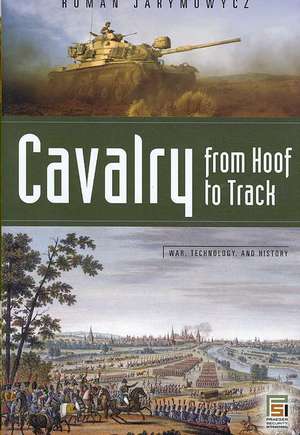Cavalry from Hoof to Track: War, Technology, and History
Autor Roman Jarymowyczen Limba Engleză Hardback – 29 dec 2007 – vârsta până la 17 ani
Preț: 324.38 lei
Preț vechi: 393.48 lei
-18% Nou
Puncte Express: 487
Preț estimativ în valută:
62.07€ • 67.63$ • 52.30£
62.07€ • 67.63$ • 52.30£
Carte tipărită la comandă
Livrare economică 23 aprilie-07 mai
Preluare comenzi: 021 569.72.76
Specificații
ISBN-13: 9780275987268
ISBN-10: 0275987264
Pagini: 316
Dimensiuni: 156 x 235 x 29 mm
Greutate: 0.64 kg
Editura: Bloomsbury Publishing
Colecția Praeger
Seria War, Technology, and History
Locul publicării:New York, United States
ISBN-10: 0275987264
Pagini: 316
Dimensiuni: 156 x 235 x 29 mm
Greutate: 0.64 kg
Editura: Bloomsbury Publishing
Colecția Praeger
Seria War, Technology, and History
Locul publicării:New York, United States
Notă biografică
ROMAN JARYMOWYCZ is a lecturer at the Royal Military College of Canada and holds a doctorate in Military History from McGill University. He commanded The Royal Canadian Hussars, an armored cavalry regiment, and is now retired as Dean of the Canadian Forces Militia Command and Staff College. As an author, he has published articles and books specializing in the Operational Art.
Recenzii
Public libraries/general collections.
The cavalry and its doctrine are misunderstood, and its tactics and operations remain a mystery for many civilians. New technology and the increased integration of the armed forces have created the illusion that the cavalry no longer exists as a distinct military entity and philosophy. Jarymowyez clarifies these misconceptions by offering a comprehensible overview, while explaining military terminology and outlining basic cavalry principles. This well written and timely book concludes by suggesting ways in which the cavalry will continue to evolve in response to contemporary Fourth Generation conflicts, perhaps even reverting to its original, tactical role of close-quarter combat.
The cavalry and its doctrine are misunderstood, and its tactics and operations remain a mystery for many civilians. New technology and the increased integration of the armed forces have created the illusion that the cavalry no longer exists as a distinct military entity and philosophy. Jarymowyez clarifies these misconceptions by offering a comprehensible overview, while explaining military terminology and outlining basic cavalry principles. This well written and timely book concludes by suggesting ways in which the cavalry will continue to evolve in response to contemporary Fourth Generation conflicts, perhaps even reverting to its original, tactical role of close-quarter combat.








